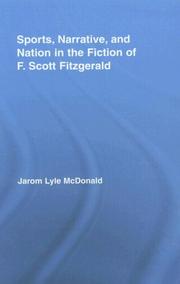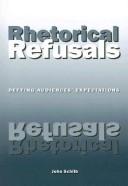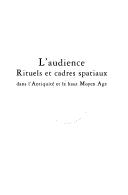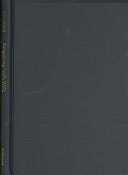| Listing 1 - 5 of 5 |
Sort by
|

ISBN: 9780742539792 0742539792 9780742539808 0742539806 1299785719 1461642914 9781461642916 Year: 2007 Publisher: Lanham, Maryland : Rowman & Littlefield Publishers, Inc.,
Abstract | Keywords | Export | Availability | Bookmark
 Loading...
Loading...Choose an application
- Reference Manager
- EndNote
- RefWorks (Direct export to RefWorks)
This book argues that sport is essential to the social health of any society. Participation in the sport fan experience is very meaningful for a significant portion of the membership of any society. This volume argues that sports fan violence, particularly celebrating riots after championship play, disturbs and harms one of the key positive aspects of sports.
Sports spectators --- Violence in sports --- Sports spectators -- North America. --- Sports spectators. --- Violence in sports -- North America. --- Violence in sports. --- Social Sciences --- Recreation & Sports --- Spectators, Sports --- Sports --- Sports fans --- Sports violence --- Spectators --- Violence --- Audiences --- Fans (Persons) --- North America. --- USA. --- Turtle Island

ISBN: 0415981336 9780415981330 Year: 2007 Publisher: New York London Routledge
Abstract | Keywords | Export | Availability | Bookmark
 Loading...
Loading...Choose an application
- Reference Manager
- EndNote
- RefWorks (Direct export to RefWorks)

ISBN: 0809387611 1435663543 9781435663541 9780809387618 9780809327898 0809327899 1299828701 Year: 2007 Publisher: Carbondale : Southern Illinois University Press,
Abstract | Keywords | Export | Availability | Bookmark
 Loading...
Loading...Choose an application
- Reference Manager
- EndNote
- RefWorks (Direct export to RefWorks)
The first book to explore rhetorical refusals-instances in which speakers and writers deliberately flout the conventions of rhetoric and defy their audiences' expectations- Rhetorical Refusals: Defying Audiences' Expectations challenges the reader to view these acts of academic rebellion as worthy of deeper analysis than they are commonly accorded, as rhetorical refusals can simultaneously reveal unspoken assumptions behind the very conventions they challenge, while also presenting new rhetorical strategies.Through a series of case studies, John Schilb demonst
Audiences --- English language --- Audiences, Communication --- Communication audiences --- Communication --- Spectators --- English literature --- Psychological aspects. --- Style. --- Rhetoric. --- Social aspects --- Metrics and rhythmics --- Style --- Rhetoric --- Germanic languages

ISBN: 9782708407961 2708407961 2369430583 Year: 2007 Volume: 6 Publisher: [Paris] : Picard,
Abstract | Keywords | Export | Availability | Bookmark
 Loading...
Loading...Choose an application
- Reference Manager
- EndNote
- RefWorks (Direct export to RefWorks)
La notion d'audience, telle qu'elle est abordée dans ce volume, s'entend de toute tenue d'assemblée ou réception solennelle mettant en présence des personnages de statut supérieur et des subordonnés ou demandeurs ; les motivations peuvent en être d'ordre politique, judiciaire ou religieux notamment. Il n'est guère besoin d'insister sur le caractère essentiel de ce processus en tant que clé d'un ample volet des rapports humains : cela pour la consolidation des hiérarchies, la définition des normes de comportement ou de pensée, et même l'instauration d'un authentique dialogue entre corps sociaux ou ressortissants de divers états ou factions. C'est donc dans une perspective d'anthropologie historique que s'inscrit ce recueil d'études qui, de manière équilibrée, s'attache à prendre en compte les aspects suivants : - les intervenants de l'audience : leur qualité, les circonstances qui les déterminent et leurs objectifs ; - les protocoles qui régissent l'acte, et les usages qui éventuellement l'accompagnent, en particulier certaines pratiques conviviales comme le banquet ; - le lieu de l'audience : le choix du site, de l'édifice qui l'accueille (éventuellement dans sa relation avec un complexe) mais aussi, à l'occasion, d'un espace à ciel ouvert. Pour les cas (qui restent évidemment majoritaires) d'un ensemble à caractère véritablement monumental, sa configuration architecturale, ses dispositifs mobiliers et son décor. Nombre d'avancées ponctuelles avaient déjà été opérées dans l'investigation du phénomène. L'ampleur de l'aire géochronologique qu'embrassent à Nanterre les activités de l'équipe Textes, histoire et monuments de l'Antiquité au Moyen Âge (composante de l'UMR 7041, Archéologies et sciences de l'Antiquité [CNRS, Universités Paris-I et Paris-X, ministère de la Culture]), ainsi que sa fondamentale vocation pluridisciplinaire, ont engagé à l'organisation d'un colloque international dont ces actes sont le fruit. Au-delà de la complémentarité des informations recueillies, cette manifestation visait à en amplifier notablement la portée ; cela en dégageant clairement les permanences de certaines pratiques tout en signalant leurs infléchissements au fil du temps, ainsi qu'en précisant la nature des réactions de tel milieu à l'égard de ce qui prévalait dans tel autre.
Political customs and rites --- Rites and ceremonies --- Spectators --- Civilization, Ancient --- Civilization, Medieval --- Moeurs politiques --- Rites et cérémonies --- Spectateurs --- Civilisation ancienne --- Civilisation médiévale --- History --- Congresses. --- Histoire --- Congrès --- History. --- Rites et cérémonies --- Civilisation médiévale --- Congrès --- Persons --- Audiences --- Customs and rites, Political --- Political rituals --- Rituals, Political --- Manners and customs --- Political anthropology --- Anthropology --- Social Sciences --- Social & Cultural Anthropology --- Political customs and rites - History --- Spectators - History --- Ancient history --- Hearing --- Rites et cérémonies politiques --- Jusqu'à 1500

ISBN: 9780823227334 0823227332 9780823227341 0823227340 0823247384 9786612698743 0823241025 1282698745 0823237648 0823227359 Year: 2007 Publisher: New York : Fordham University Press,
Abstract | Keywords | Export | Availability | Bookmark
 Loading...
Loading...Choose an application
- Reference Manager
- EndNote
- RefWorks (Direct export to RefWorks)
Can looking at disaster and mass death destroy us? Forgetting Lot’s Wife provides a theory and a fragmentary history of destructive spectatorship in the twentieth century. Its subject is the notion that the sight of historical catastrophe can destroy the spectator. The fragments of this history all lead back to the story of Lot’s wife: looking back at the destruction of the cities of Sodom and Gomorrah, she turns into a pillar of salt. This biblical story of punishment and transformation, a nexus of sexuality, sight, and cities, becomes the template for the modern fear that looking back at disaster might petrify the spectator. Although rarely articulated directly,this idea remains powerful in our culture. This book traces some of its aesthetic, theoretical, and ethical consequences. Harries traces the figure of Lot’s wife across media. In extended engagements with examples from twentieth-century theater, film, and painting, he focuses on the theatrical theory of Antonin Artaud, a series of American films, and paintings by Anselm Kiefer. These examples all return to the story of Lot’s wife as a way to think about modern predicaments of the spectator. On the one hand, the sometimes veiled figure of Lot’s wife allows these artists to picture the desire to destroy the spectator; on the other, she stands as a sign of the potential danger to the spectator. These works, that is, enact critiques of the very desire that inspires them.The book closes with an extended meditation on September 11, criticizing the notion that we should have been destroyed by witnessing the events of that day.
Audiences --- Influence (Psychology). --- Memory. --- Recollection (Psychology). --- Spectators --- Suffering. --- Violence. --- Psychology. --- Influence (Psychology) --- Recollection (Psychology) --- Recall (Psychology) --- Memory --- Recognition (Psychology) --- Retention (Psychology) --- Intellect --- Psychology --- Thought and thinking --- Comprehension --- Executive functions (Neuropsychology) --- Mnemonics --- Perseveration (Psychology) --- Reproduction (Psychology) --- Persons --- Audiences, Communication --- Communication audiences --- Communication --- Affliction --- Masochism --- Pain --- Violent behavior --- Social psychology --- Conformity --- Example --- Persuasion (Psychology) --- Social aspects
| Listing 1 - 5 of 5 |
Sort by
|

 Search
Search Feedback
Feedback About
About Help
Help News
News